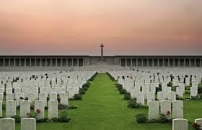| First Name: | Sidney Walter | Last Name: | SANFORD | |
|---|---|---|---|---|
| Date of Death: | 23/03/1918 | Lived/Born In: | Regent's Park | |
| Rank: | Rifleman | Unit: | Rifle Brigade2 | |
| Memorial Site: | Pozieres Memorial, France | |||
Current Information:Military Medal Born-City of London
In the Spring and early summer of 1918, the Germans launched four major offensives against the Allied line in France and Belgium which came close to ending the war in their favour. This was made possible by the end of the fighting on the eastern front after the Russian revolution, which allowed the German Army to bring its troops from there to France, where it was hoped a decisive effort would win the war in their favour before the Americans arrived in force. The Germans very nearly succeeded with their attacks. Their new tactics of a intense artillery barrage followed by groups of specially trained storm troopers forging swiftly ahead, by-passing any strongpoints, caused chaos among the defenders and remarkable gains in territory were initially seen. The old system of trench warfare soon became a thing of the past. But in each case the Germans over extended themselves and without adequate supplies keeping up with their rapid advances, they could go no further. By late summer, the Germans were exhausted, the Allies had regrouped and were then able to begin their own series of offensives which led to the collapse of the German Army and victory before the end of the year. The first of these attacks, Operation Michael, began on 21st March, 1918, when the German Army launched a major offensive, also known as the Kaiserschlacht (Kaiser's Battle) on the British line, running south from Arras to Chauny, close to the junction with the French Army. It was made by 63 specially trained divisions, attacking along a 60 mile front held by 26 British divisions, many of them in a weakened state. Aided by early morning mist during the opening days of the battle, the Germans made spectacular gains and within two weeks the British had been pushed back to the gates of Amiens. It was touch and go for the British Army who were in danger of being separated from the French and forced back to the Channel ports, but they rallied and with the agreement that Field Marshall Foch should co-ordinate all Allied movements, this worst case scenario was averted. At 4.40am on 21st March, all along the 50 mile front, the German artillery opened up with the most ferocious and concentrated bombardment of the war, the likes of which the British had never experienced before. The Forward Zone, consisting mainly of individual posts was blown away. Very few of the men there made it back. Many were killed and many more were taken prisoner. The Battle Zone was also battered as were the British guns, firing from positions just to the rear. Brigade and Divisional HQs were also targeted and then, from out of the thick mist came the German storm troopers. Moving fast, they skirted round the few remaining strongholds and penetrated deep into the British lines, including those of the Battle Zone, causing the utmost confusion. There were many cases of heroic stands being made but the relentless pressure forced the British back everywhere and there then began a general retreat that went on for two weeks and which ceded to the Germans a huge amount of territory, including all of that that had been won at such great cost during the Battle of the Somme in 1916. When the German offensive began on 21st March, 8th Division were out of the line undergoing training near St. Omer but the events further south meant that reinforcements were desperately needed. On 23rd March, the 2nd Rifle Brigade battalion, along with the rest of 25 Brigade moved to the battle front by rail detraining at Rosière-en-Santerre and moving by lorries to Morchain. 25 Brigade were ordered to occupy the line on the west bank of the canal from Rouy-le-Grand to Pargny, relieving the hard-pressed 50th Division. 2nd East Lancashire were on the right, 2nd Berkshire in the centre and 2nd Rifle Brigade on the left. Moving towards Pargny 2nd Rifle Brigade had to face heavy artillery fire whilst crossing the high ground before taking over the line on the river and canal from south of Fontaine-les-Pargny to north of the Pargny bridge. There is no record in the Battalion Diary concerning the rest of the day other to say that just before midnight-parties from 2nd Rifle Brigade and 1st Worcestershire ejected a German patrol which had crossed the bridgehead at Pargny and penetrated between the front and support lines and that the casualties for the day amounted to over sixty. Just before dawn on the following day, 24th March, the enemy bombarded the posts held by 2nd Rifle Brigade on canal banks at Pargny, forded the canal either side of the battalion and then worked round their flanks. 2nd Rifle Brigade were forced to fall back, suffering heavy losses as they did. They then took up a position along a sunken road 500 yards east of Morchain but after an hour withdrew a further 300 yards to a position on the north-east edge of Morchain. By now their strength had been reduced to about one hundred officers and men and still the pressure on them continued. At 4pm, with the Germans massing in front of them, 2nd Rifle Brigade were ordered to withdraw to old trenches astride the Morchain-Pertain road, north of Potte, where the rest of 8th Division were assembling. During these first two days of fighting the battalion suffered heavy losses, one of whom was Sidney Sanford. |
||||
| « Back to Search Results | ||||
| If you think any of the information shown here is incorrect, Click Here to submit your amends and comments | ||||




